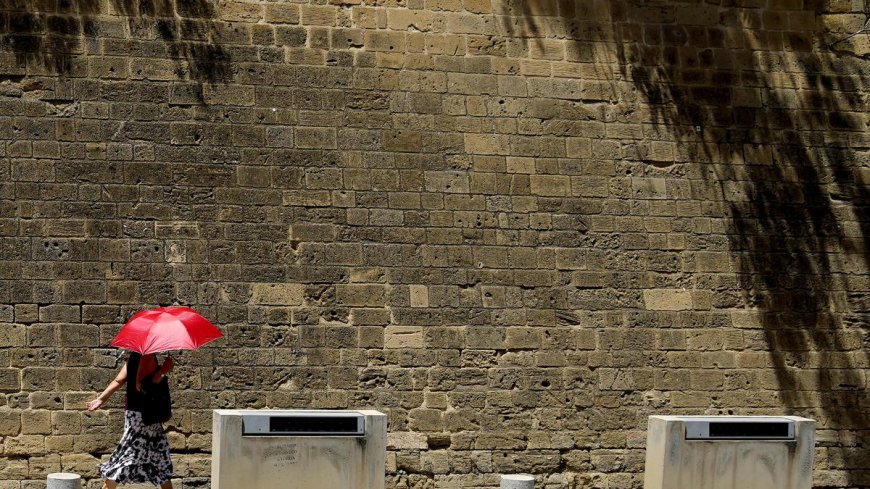Assessing temperature-related deaths in urban heat islands

Assessing temperature-related deaths in urban heat islands
By Anjali Desai
Asarkari - Sarkari News, Jobs & Updates
kam sabdo me kahein to: Urban heat islands significantly increase temperature-related death risks, but accurately assessing these fatalities is challenging due to reporting issues and delayed effects, requiring better data and methods to protect vulnerable populations.
Introduction: The Silent Threat in Our Cities
As cities expand and climate change intensifies, a hidden danger looms large: the urban heat island (UHI) effect. This phenomenon, where metropolitan areas experience significantly higher temperatures than their surrounding rural counterparts, is not just an uncomfortable reality; it's a growing public health crisis. Extreme heat is a known killer, and within these urban hotspots, the risk of temperature-related illness and death escalates dramatically. However, understanding the true scale of this problem requires careful assessment, a task fraught with complexity but crucial for implementing effective life-saving measures.
Understanding the Urban Heat Island Effect
Why are cities so much hotter? Several factors contribute to the UHI effect. Dark surfaces like asphalt roads and conventional roofing absorb and retain vast amounts of solar radiation, releasing it slowly as heat, especially noticeable during evenings. The lack of extensive tree cover and green spaces reduces the cooling effect of shade and evapotranspiration (the process where plants release water vapor). Furthermore, waste heat generated from buildings (air conditioning units), vehicles, and industrial processes adds to the thermal load. This combination creates pockets of intense heat, often varying significantly even within the same city, disproportionately affecting densely built-up areas and neighbourhoods with less green infrastructure.
The Deadly Link: Heat Stress and Mortality
Extreme heat poses a direct threat to human health. Prolonged exposure can overwhelm the body's natural cooling mechanisms, leading to conditions like heat exhaustion and, in severe cases, life-threatening heatstroke. However, the impact of heat extends beyond these direct heat illnesses. High temperatures place immense strain on the cardiovascular and respiratory systems. This means that heatwaves often lead to a surge in deaths from heart attacks, strokes, and respiratory failure, particularly among vulnerable populations. These groups include the elderly, young children, individuals with pre-existing chronic conditions (like diabetes, heart disease, or lung problems), outdoor workers, and those living in low-income communities who may lack access to air conditioning or adequate healthcare. The physiological stress induced by relentless heat can tragically push already compromised systems over the edge.
The Challenge: Accurately Counting Heat-Related Deaths
Pinpointing exactly how many deaths are directly attributable to high temperatures within urban heat islands is surprisingly difficult. One major hurdle lies in how mortality is recorded. Death certificates typically list the immediate cause of death (e.g., "cardiac arrest" or "respiratory failure") and underlying conditions. Heat exposure, even if it was the critical trigger, is often not mentioned or listed only as a contributing factor, if at all. This underreporting makes it challenging to gather accurate statistics solely based on death certificate data.
Furthermore, the effects of heat aren't always immediate. A person might suffer heat stress during a peak heatwave but succumb to complications days or even weeks later. This temporal lag complicates efforts to directly link mortality spikes to specific heat events. There's also a lack of globally standardized methodology for classifying and reporting heat-related deaths, leading to inconsistencies across different cities, regions, and countries. Comparing data and understanding the global burden becomes significantly harder.
Researchers often rely on epidemiological studies and statistical modelling to estimate the 'excess mortality' during heatwaves – comparing the number of deaths during a hot period to the expected number based on historical averages for that time of year. While these methods provide valuable insights into the overall impact, they require robust baseline data and sophisticated analysis, which may not be available everywhere, particularly in resource-limited settings.
Moving Forward: Better Assessment and Mitigation
Improving the assessment of temperature-related deaths is vital for developing targeted interventions. This requires enhancing death certification processes to better capture the role of environmental factors like heat. Implementing standardized reporting protocols internationally would allow for more accurate comparisons and a clearer global picture.
Beyond better counting, proactive measures are essential. Effective heat-health warning systems, integrated with meteorological forecasts and public health advisories, can alert citizens and healthcare providers to impending risks. Urban planning strategies must prioritize heat mitigation: increasing green cover through parks and urban forests, promoting cool roofs (using reflective materials), designing buildings for better natural ventilation, and ensuring access to public cooling centers, especially in vulnerable neighbourhoods. Public awareness campaigns educating people on recognizing heat stress symptoms and taking preventive measures are also crucial.
Understanding the precise burden of heat-related mortality helps policymakers justify investments in these adaptation and mitigation strategies. Accurate assessment validates the need for climate-resilient urban development and robust public health preparedness plans. For more updates on government initiatives and public health news, visit https://asarkari.com.
Conclusion: Protecting Citizens from Urban Heat
The urban heat island effect exacerbates the lethal potential of extreme heat, posing a significant and growing threat to city dwellers worldwide. While assessing the exact number of temperature-related deaths remains challenging due to reporting complexities and delayed impacts, it is an essential task. Improving data collection, employing sophisticated analysis, and investing in both assessment methods and mitigation strategies – from better urban design to effective warning systems – are critical steps. By acknowledging the severity of the problem and working towards accurate assessment, cities can better protect their populations from the silent, creeping danger of extreme urban heat.
- Team Asarkari
Keywords
urban heat island effect, temperature-related deaths, heatwave mortality, city climate impact, assessing heat deaths, public health risks, extreme heat effects, heat stress causes, urban planning climate change, heat mortality statistics, climate change health impact, city temperature risksWhat's Your Reaction?
 Like
0
Like
0
 Dislike
0
Dislike
0
 Love
0
Love
0
 Funny
0
Funny
0
 Angry
0
Angry
0
 Sad
0
Sad
0
 Wow
0
Wow
0








































